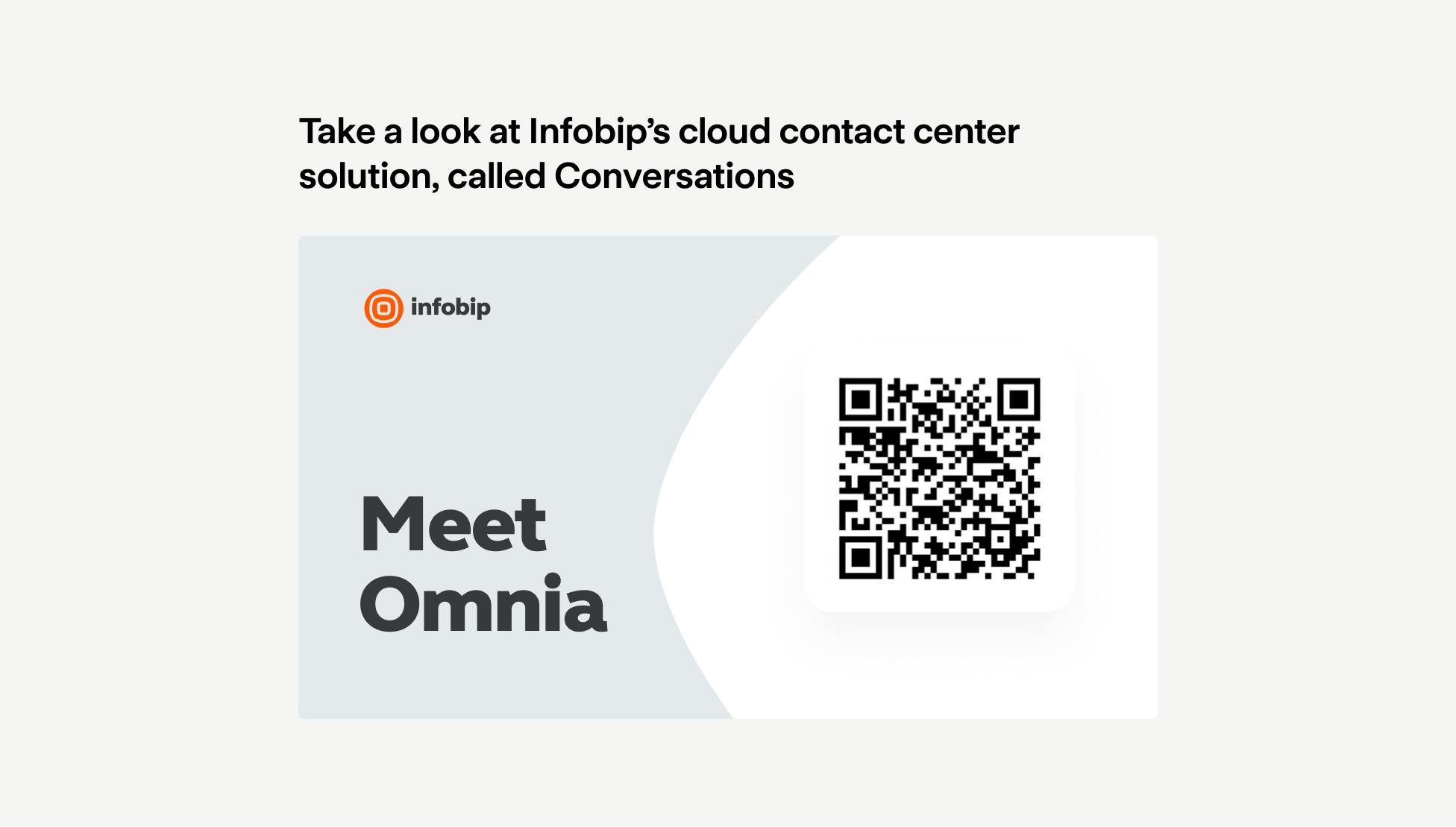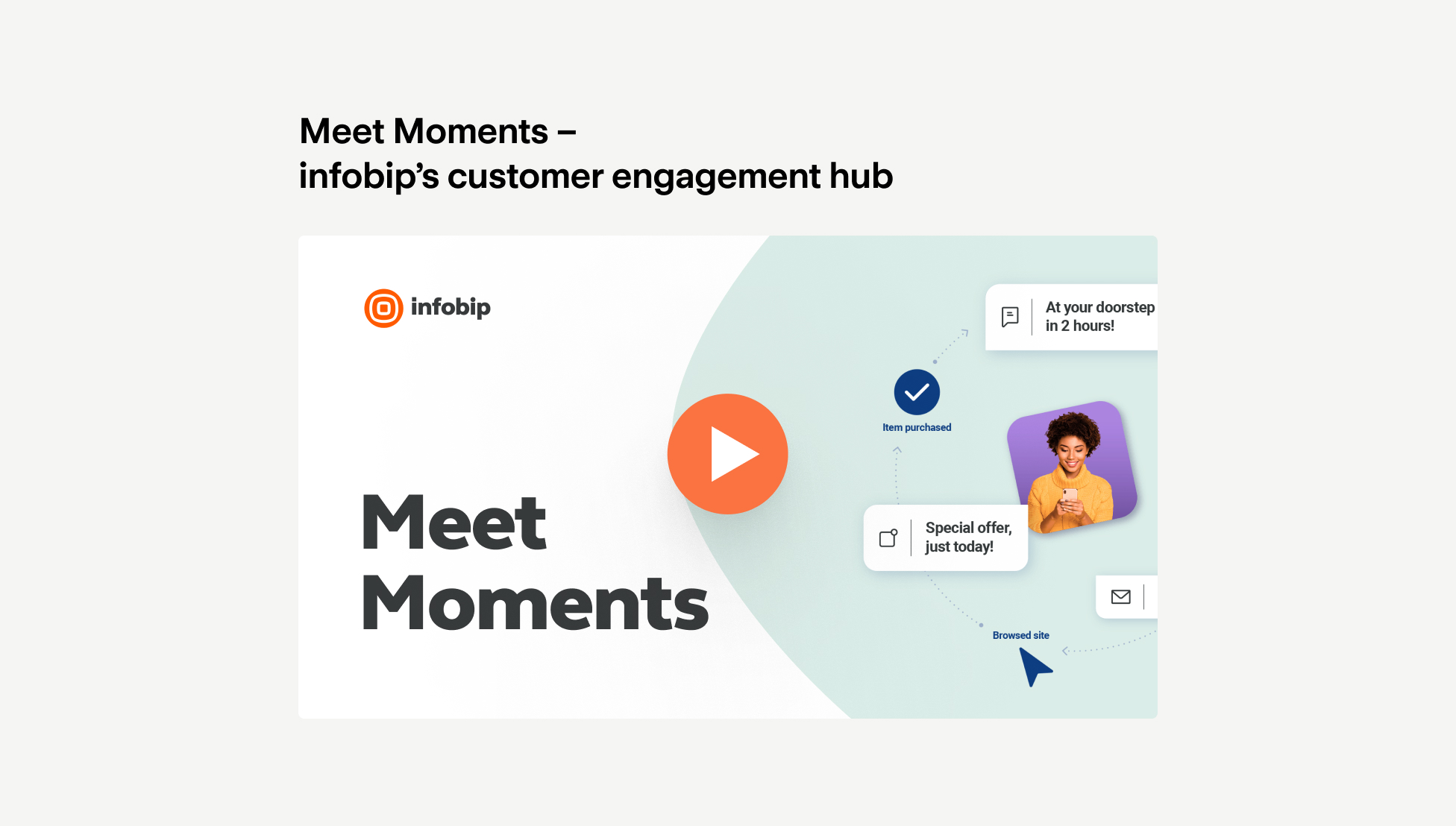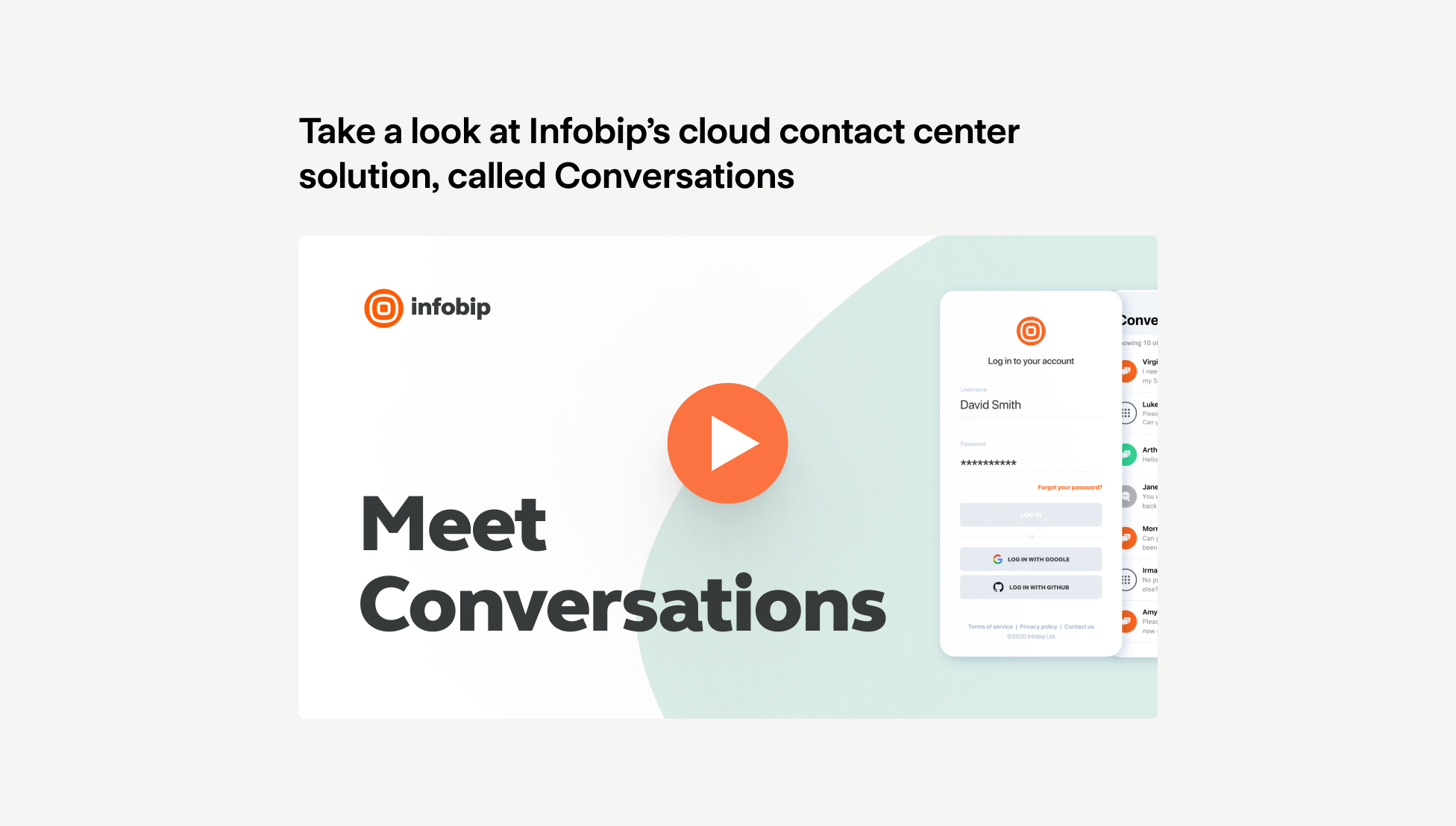Move into the omnichannel age
How to transform your digital communications – in a few easy steps
Read Time: 7mins

As an OpenMarket or Infobip customer, you know all about the power of business messaging to help customers at precise moments and in exact places.
You’re also aware the messaging horizon is broadening. First, there’s the expansion of SMS into image and video-rich, interactive formats like MMS and RCS. Second, messaging apps that operate outside the traditional inbox – such as WhatsApp, Facebook Messenger and Google Business Messages – are growing in popularity and establishing themselves as viable and powerful business tools.
But the evolution of messaging is part of a much bigger change in the business world. We’re entering an era that will be defined by automated, data-driven, multi-channel customer interactions. The businesses that ride this innovation wave will earn intense loyalty and advocacy. Those that don’t will be left far behind.
Don’t call us, we’ll call you
Compare and contrast the promise of this new era with the every-day reality of customer-business interactions. Today, even businesses seen as CX leaders accept that a large percentage of the customer experiences they offer are substandard.
Too often customers are forced to expend hours of effort to get questions answered or simple tasks completed. In fact, it’s common enterprise practice to actively discourage customers from getting in touch. How many enterprises hide phone numbers on websites and promise an email response in three-to-five days instead?
The tragic part of the story is that this poor customer service is being delivered at great cost to enterprises. Bloated contact centers, vast telecoms infrastructures, cumbersome manual processes and multiple communications applications are all profit drains. In years to come we’ll look back on this period and wonder how businesses survived.
The billion-dollar question is: What do you do next?


A clear set of next steps
The good news is a clear, straightforward digital transformation path exists for companies that already have the essential automated communication building blocks in place. As a current user of business messaging, you are one of these companies.
The even more exciting news is the integration of platforms and services from OpenMarket and Infobip presents a compelling pathway via which you can move your communications into the AI-powered digital age.
It won’t happen with a snap of the fingers. But it can be far more straightforward than you might imagine.
This interactive guide will show you how.
Multi-channel V omnichannel
Let’s define two important terms.
It’s generally accepted that the term multi-channel describes communication between businesses and customers over several discreet, siloed channels. Omnichannel, on the other hand, is applied to a more joined-up multi-channel approach.
These definitions aren’t universally subscribed to. In fact, in our view, whether you call your communications strategy omnichannel or multi-channel isn’t particularly important. But if you want to use multiple channels to communicate with customers effectively, it’s crucial that you’re able to monitor every single aspect of that customer journey. And customers must be able to pick up on one channel where they left off on another.
More on that below.
Counting channels
The terms multi-channel or omnichannel are often bandied about by communication platforms that offer just two, three or maybe four different channels to reach customers on.
But true leaders of omnichannel or multi-channel communication connect up a far wider variety of channels – including email, push notifications on apps and the web, live chat, video, social, voice and the full gamut of messaging channels.
It’s worth noting that different messaging apps are dominant in various regions across the world. For example, Facebook Messenger is popular in the US, WhatsApp is favored in the UK, Viber is huge in Eastern Europe, and KakaoTalk is widely used in South Korea.
If you’re a global business, you may well need the ability to communicate on all of them. Meeting the customer where they want to be improves the overall experience for them while instilling trust and comfort.
Interested in how messaging apps are used across the world? Take a look at our interactive infographic.
Most popular messaging apps worldwide
Interact with the map to find out more
- Telegram
- Facebook Messenger
- Viber
- Line
- Kakao Talk
- Reset Map
Omnichannel in action
No matter which channels your customers use, you need omnichannel powers to help you stay in contact via the most appropriate options, and keep track of all their interactions with your business.
The beauty of this new era of communications is it’s now more straightforward than ever to set up a strategy like this – using APIs or a self-service platform that non-technical people can use. Mobile messaging will inevitably be at the heart of this strategy.
Let’s look at some scenarios to illustrate why having so many (separate but connected) channels at your disposal is invaluable for you and your customers.
The appointment scenario
Imagine Jennifer calls a private healthcare provider, asking them to set up an appointment with a specialist. The receptionist uses a CRM to make the appointment.
With the right omnichannel solution, this event acts as a trigger for several communications: an immediate appointment confirmation via email, an SMS reminder two or three days before the agreed date, and another SMS reminder two hours before the appointment time.
The first SMS asks for confirmation that Jennifer is attending her appointment. If she doesn’t answer to confirm, the next step is a further SMS prompt. If this also goes unanswered a ticket is sent to a customer services operative to make an in-person confirmation call. Alternatively, a recorded voice message could be sent.
If there is no response from Jennifer 24 hours before the appointment, an automatic cancellation is triggered – with an associated chain of communications specific to this event. This sequence is straightforward to program automatically because at every stage of Jennifer’s patient journey, information is fed back into the healthcare provider’s CRM.
People – build customer profiles
People is Infobip’s customer data platform (CDP), which orchestrates all your customer information. It connects with your CRM and delivers the information needed for your behavior-based interactions with customers.


In the above scenario, using different channels gives the provider the best chance of eliciting a response. It is also possible to collect data points about patients to inform educated guesses about which type of communication Jennifer is most likely to respond to.
Somewhere in this sequence of communications – perhaps if Jennifer confirms she is unable to attend as planned – the provider could include an option to offer a video appointment. If she accepts this option, a link to a secure video chat could be sent via email or SMS. Or the video conversation could take place within the provider’s app.
Data-driven communication
The appointment scenario is a relatively well-known workflow for many businesses. Now let’s look at some other – less familiar – parts of a customer journey that can be connected up in order to enhance experience and bring enterprise efficiency.
Imagine Carlos is on an insurance company’s website. He already has a home insurance policy with the insurer so he logs into his account. The log-in itself is noted as an event by the omnichannel solution. Carlos starts filling in a motor insurance policy application form. This becomes another event.
But Carlos is distracted and doesn’t complete the form. This information can also be tracked and fed back into the insurer’s CRM. Meanwhile a mobile message is sent to remind Carlos to fill in the form. If this doesn’t work, an email is triggered.
Let’s assume Carlos bought his car policy. Some months later he is driving in San Diego and collides with a van that steers into his path. Instead of calling the insurer and waiting in line, Carlos opens the insurer’s app right at the scene and starts a chat with an AI-powered chatbot:
If Carlos doesn’t have the app, he can contact the insurer’s chatbot via RCS, then send in photos of the scene via this channel. Live agents can monitor these chatbot conversations and take over where appropriate.
The flows you set up for your customers can be nuanced, multi-channel and multi-conditional. Or they can be devastatingly simple. There are endless ways to creatively use push, email, phone calls, SMS, RCS, and chat apps – on their own or combined.
A true omnichannel capability allows you to craft user journeys that are good for you and your customers. This can all be done via a simple-to-use SaaS interface or via REST APIs.
A unified system
The allure of omnichannel is to have all your channels form part of one data-driven, event-led, system. You can bring simplicity to a complex web of communications – with one provider handling the communication routing, the integrations and registrations with the apps and communication providers, the data analytics, the AI, and every aspect of an omnichannel arsenal.
CCaaS ( Contact centre as a service)
Compare integrating an omnichannel solution such as this with the complexity of running a fully-staffed contact center – with all the associated telecoms, technology, people management and routing that involves. In comparison, this is a walk in the park. Your agents can use a single interface from which they can interact with and orchestrate omnichannel support for all your customers. It’s also worth noting that, with the right omnichannel contact center solution, you don’t even need a telecoms system.
Social and search
Opportunities to insert your business into untapped parts of the customer journey are constantly emerging. When your customer is posting on Facebook or Instagram, or using Google’s search engine or Maps functionality, there are opportunities for you to help them.
Let’s say Matthew posts a message on your Facebook page complaining about a missed delivery. This can trigger a ticket to an agent advising them to intervene by sending a Facebook direct message. Alternatively, this event can trigger an automated message that contains a discount token by way of apology.
Perhaps Karen is searching for one of your stores or restaurants on Google Maps. You can ensure a message icon appears under the map listing. A quick tap on that icon can connect Karen directly to your own chatbot on Google Business Messages.
Chatbots explained
Chatbots will play a huge role in enterprise communications of the future. So it’s worth exploring how you can go about setting up a chatbot in a messaging application.
Rule-based keyword chatbots can provide quick answers to customer queries with the ¨if/then¨ logic common in automated SMS interactions.
Intelligent chatbots, on the other hand, are powered by artificial intelligence (AI) and natural language processing (NLP). These chatbots require a certain amount of training to prepare them for all the circumstances under which a customer might want to talk to you.
This is a straightforward process for a chatbot expert. If you’re an airline, the training will be around flights, connections, bookings etc. If you’re a retailer, products, stores, offers and the like will need to be covered.
Chatbots can also make API calls to retrieve information. If we imagine the airport scenario, a customer might ask the chatbot about a gate number for a particular flight. The chatbot can then make an API call to the airport’s system, and receive the information it needs.
If a chatbot is unable to resolve a customers’ issue, a live agent can be sent a ticket suggesting they take over. You can also set up a system through which an agent monitors chatbot interactions.
Why not check out Infobip’s intelligent chatbot using the Q-code below.

What’s next for omnichannel engagement?
Automated, intuitive, AI-powered experiences are the future of customer communications. As time goes by, human customer service experts will deliver value in different and more efficient ways – enabling you to offer bigger audiences better levels of both human and automated support.
The coming together of AI, a wide variety of channels, and human support in one integrated system gives you a chance to stay in touch with customers at all times. Just think about the big strategic U-turn this could inspire. You could actually encourage your customers to connect whenever they have a question – no matter how small – rather than trying to put them off!





